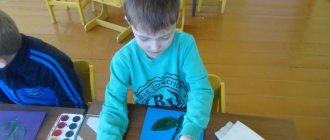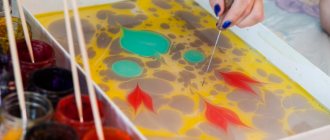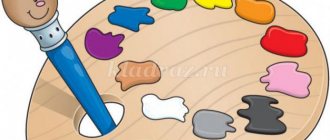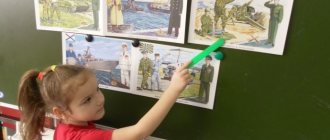Psychologists have long proven that drawing has a beneficial effect on the child, the development of his speech, imagination, fine motor skills and coordination of movements. And parents who, for one reason or another, had to contact a child psychologist with their baby, probably know that at the beginning of the appointment, the specialist asks the child to draw a picture - of his family, friends or beloved pet. Experts have found that with the help of drawing, the toddler best understands the world around him.
The benefits of drawing for child development
Drawing for children 5-6 years old not only brings pleasure, but is also an excellent way to improve creative and intellectual skills. Children in preschool age think figuratively, so creating new images and regular drawing classes contribute to their better development.
Drawing lesson in kindergarten
During creative activity, the child experiences the following changes:
- development of creativity;
- the ability to create many new images and change details at your discretion;
- the ability to associate one's works with objects, people or animals.
Note! Playing associations in the process of creating a picture helps to train imagination, mind, thinking, and also represents a replacement for the most modern methods of child development.
Class notes
Theme of the week: “I take one berry”
Lesson 1. Branch with berries (Drawing with colored pencils)
Program content.
Continue to introduce children to the variety of berries. Learn to copy from a picture, correctly convey the shape of the leaves, location and color of the berries. Strengthen the ability to fill out a sheet compositionally.
Demonstration material.
Subject pictures with drawn branches or bushes with berries (red currants, black currants, gooseberries, raspberries, strawberries, wild strawberries, etc.).
Handout.
Halves of album sheets, simple and colored pencils.
How to get your child interested in drawing
If a preschooler has even the slightest craving for drawing, parents should think about developing his abilities. To prevent your child from losing interest in creativity, you can enroll him in an art club, studio, or resort to individual training with a private teacher.
It is strictly not recommended to enroll a child in a specialized institution against his will. The toddler must attend classes with pleasure, otherwise it will not bring any results.
Should I send my child to a drawing class?
Today, many parents send their children to specialized clubs. Here the children feel good, as they not only learn artistic activities, but also communicate with their peers. Before you take your child to classes, you need to make sure that he is really interested in this type of art.
Should a child attend a club?
Note! Do not forget that preferences in preschool age are unstable, so today the little one wants to study at an art school, but tomorrow he doesn’t.
Image techniques
Popular methods and techniques of depiction are represented by the use of nature, reproductions of paintings, a sample or any other visual aid. A nature is an object or phenomenon that a child must draw in the process of direct observation. At early preschool age, children can already perceive an object in the totality of its qualities.
But it is worth noting that depicting an object using a template or from life requires the ability to analyze the relationship of individual elements and their location in space.
Breathing exercises for children 4-5 years old in kindergarten
Teaching drawing to a 4-5 year old child
Drawing lessons for children 4-5 years old are aimed at teaching artistic and creative activities. All materials that are selected in advance by the teacher must be available to preschool children. They must understand the essence of the topic in order to correctly depict a certain subject on paper.
How to teach drawing to a preschooler aged 4 to 5 years
Many people often wonder how to teach a child to draw at 5 years old. The family plays an important role in this process. Before taking your child to kindergarten, you need to create a favorable atmosphere at home, for example, invite your child to play with markers and pencils. It is advisable to depict several patterns together.
Important! If simple drawing lessons for a 4-year-old child are interesting, then you can start doing complex details, for example, correctly making lines, contours, strokes.
The benefits of drawing for child development
The benefits of drawing for children are scientifically proven:
- artistic activities develop fine motor skills, which stimulates areas of the brain responsible for thinking, speech, visual and motor memory, and coordination. During drawing, both hemispheres of the brain are involved, interhemispheric connections actively arise;
- the child develops spatial intelligence, as well as imagination;
- through drawing, the child expresses himself, projects his psychological state on paper;
- Painting for children is considered a calming activity. It is especially useful to draw for children prone to whims, depression, and neuroses;
- systematic painting lessons teach the child to structure time, develop perseverance, and form discipline;
- Through painting, children learn to creatively comprehend the world around them and understand that each person has his own perception of reality, sees objects or phenomena in his own way.
What benefits does artistic activity bring to a preschooler?
Workspace organization
In order for a preschooler to be able to draw at home, he needs to prepare a workplace. The child must see the entire image, so to draw, you should take an easel or draw on the floor. Special attention should be paid to lighting, since the light should fall from the opposite side from the hand with which the baby is drawing.
An example of organizing a workplace for children
As for working materials, the water should be on the right (if the baby is left-handed, then on the left), the paints should be above the drawing or near the water, and the palette for mixing colors should be in the hands. If the palette stands near the paints, then during the work you can accidentally drip onto the painting, ruining it.
Senior group. Senior preschool age. Children 5-6 years old
Drawing in the senior group “White birch tree under my window...”
Educator: Today an exhibition of paintings opened in our group, and I invite you to visit this exhibition. Children enter the art studio to the music and stand near the blackboard. Several landscapes are displayed on the board. Educator: Children, tell me, what did artists depict in landscape paintings?...
Drawing “White birch under my window” with elements of appliqué using the “nitcography” technique with children 5 years old
Teacher of the highest qualification category Kurnina Lyubov Vladimirovna MBDOU kindergarten No. 54 “Teremok”
Kovrov, Vladimir region.
Dear colleagues, I bring to your attention a photo report on the drawing “White Birch Tree Under My Window”
with elements of appliqué using the technique...
Where to start when teaching a child to draw
Drawing with children 5-6 years old is not only the process of creating an image with paints or colored pencils. A young creator may prefer other techniques, so parents should first buy their child felt-tip pens, gouache or watercolors and crayons.
Techniques for developing drawing skills
It is not at all necessary to apply paint to paper with a brush, because for this you can use foam sponges, cotton swabs or threads. Each technique is capable of developing certain skills in a preschooler: some will be better, and some will be worse.
Important! Parents must remember that constant criticism can discourage children from creating. Because of failures, the little one is often upset and disappointed, so he should be supported.
Interesting drawing ideas
In the process of creating a picture, you can invite children to draw a fictional planet with its nature and fantastic animals, after which it will be interesting to name it. Another unconventional drawing idea for 5-year-olds is to create a still life or autumn landscape using feathers, which you dip in paint and make fancy designs on a sketchbook sheet. The result should be interesting and original work.
Best drawing techniques for 3-4 years old
Let's look at some drawing techniques for children 3-4 years old.
How and with what to draw?
Hatching
The point of this technique is to paint over any area without going beyond the boundaries of the drawing. It is better to do shading with a pencil or pen.
Invite your child to color the bunny gray.
coloring book "bunny"
fish coloring page
We color the fox red.
fox coloring page
Shading
Shading is similar to shading, but is done with paints. The meaning is the same - to paint over a certain area. For example, it is very interesting to draw colorful circles using plastic cups, and then paint them in a suitable color.
Lines
Straight, wavy, interrupted, spiral, etc. Here is an example of how you can draw the sky, grass and sun with different lines.
line drawing sky and grass
sun line drawing
Points
This is one of the first techniques that children learn and their favorite. Children can use this technique to paint sand, rain, snow, flies, etc. For example, you can decorate a pineapple with dots using a brush.
Pineapple dot pattern
Or draw a clover with cotton swabs.
Drawing with cotton swabs
Splashes and blots
If splashes and blots are usually considered something untidy, then in this technique everything is just the opposite. Here is an example of a beautiful butterfly made from a blot. We painted the blot on paper with different colors and then simply folded it in half. However, to get a butterfly pattern, you need to practice a little in applying paint.
Blot butterfly
But such a monster can be made if you apply paint with a lot of water to a sheet of paper, and then blow on the drops of paint into a tube. Under air pressure, the drop will flow, leaving a mark on the sheet of paper.
Blob Monster
An interesting messy picture is obtained if you apply finger paints or gouache to a sheet of paper.
Liquid paints
Then we press them with transparent film.
Press down with film
By pressing the film onto the paints, you can see how the colors spread and mix. And as a result, we get an interesting pattern!
Drawing from smeared paints
Watercolor over crayon drawing
The point of the technique is to draw a design with a white wax crayon or candle on white paper. He won't be visible. Then, when a layer of watercolor is applied on top, the drawing begins to magically “appear.”
Kids will probably be able to draw rain with horizontal lines.
Chalk drawing “Rain”
It’s a real miracle when the spirals drawn in chalk begin to appear.
Chalk drawing “Spirals”
You can draw fish in the same way and then cut them out.
Chalk drawing "Fish"
Seals and stamps as a drawing technique
The meaning of the technique is that the design is applied to a sheet of paper not with a brush, but with a seal. Let's see what you can use to make a print for a child: An amazing flower can be obtained if folded celery leaves are used to apply it.
Celery stalks
A celery print makes a very beautiful rose.
Celery imprint
You can cut a convenient stamp out of potatoes, for example, in the shape of a leaf.
Potato stamp
Nature itself gives us ideas. If you apply green and brown paints to a sprig of cauliflower, the imprint of the cauliflower is very similar to a spreading tree.
Cauliflower tree
Stamp using a dishwashing sponge. To do this, dip a sponge in paint and apply the design to the paper.
Autumn sponge drawing
Drawings made with bubble wrap prints will also find their lover. The mixture of pink and white flowers on the prints gives a touching tenderness to spring sakura.
Bubble wrap print pattern
Imprint of a rubber ball with spikes. Just like when working with a sponge, we dip the ball in the paint and run it across a sheet of paper, getting a funny dotted print.
Rubber hedgehog drawing
A paper mouth, eyes and ears will help bring our drawing to life.
Monster
Finger paintings
You can use your fingers to draw dots, lines, or cover a certain area. Here we decorated an autumn tree with dotted movements.
Autumn finger painting
You can simply smear the paint with your fingers, filling the selected contour.
Coloring the fruits
Drawing from a pen print
The point of the technique is to make an amazing picture from a pen print by adding a few additional strokes to the print. For example, we can make green prints and add orange rectangles to them - we get a carrot.
Drawing from prints “Carrot”
Or glue toy eyes to the print and add a mouth - you get a real goldfish.
Drawing from the print “Fish”
A very touching picture drawn with palms and fingers “nest”. Children will be able to draw birds, and also find out with what love the mother bird incubates her eggs and feeds her babies.
Drawing with palms and hands “nest”
A very interesting way of drawing is to draw something three-dimensional on a large poster or the back of unwanted wallpaper. This way you can do group work.
Volumetric drawing
We looked at several drawing techniques for children aged 3 to 4 years. However, things can go wrong. Paint may spill, water may overturn, and clothes may get dirty. Try not to get upset or upset your child. Believe - next time everything will work out! A lot of things just come with experience.
See how you can draw a hedgehog with your child:
How to teach a child to draw with pencils and paints step by step
In order for the toddler to draw with a pencil, you need to help the child hold it in the correct position. The parent should take the child’s hand with a pencil in his own, and then draw straight and wavy lines and simple shapes together. As soon as the preschooler masters simple large forms, you can complicate the tasks and begin to depict small details: a hare, a bullfinch, flowers in the spring or snowflakes in the winter.
Dance classes for children 3, 4 and 5 years old
As for learning to work with paints, it consists of several stages:
- prepare soft bristle brushes, a sippy cup, watercolor paints and a palette;
- teach your child to hold a brush and use it: pick up paint, apply it to the easel, blot and rinse;
- At the first stage, the little one must move a dry brush over the paper, determine the degree of pressure and the correctness of the movements.
The process of learning to paint with paints
You should draw step by step, starting with one color, gradually adding other shades. To begin with, it is recommended that the child draw strokes according to the diagram, lines and simple figures from closed contours to be painted.
Recommendations from psychologists and teachers
According to Daria Nikolaevna Koldina’s notes (which are available online), teachers do not recommend overloading children during drawing classes, otherwise, instead of enjoying a rich and interesting life, the little one will suffer from fatigue and frayed nerves. If perseverance is not one of the child’s virtues, then there is no need to force him to study, since he must come to this on his own.
As for the break between school lessons and drawing classes outside of school, psychologists recommend that it be at least an hour. Thus, a five- to six-year-old preschooler will be able to “switch” and begin another type of activity with renewed vigor.





